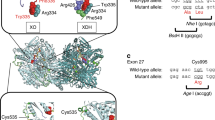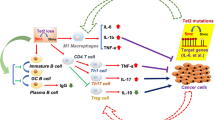Abstract
Histidine decarboxylase (HDC), the unique enzyme responsible for histamine generation, is highly expressed in myeloid cells, but its function in these cells is poorly understood. Here we show that Hdc-knockout mice show a high rate of colon and skin carcinogenesis. Using Hdc-EGFP bacterial artificial chromosome (BAC) transgenic mice in which EGFP expression is controlled by the Hdc promoter, we show that Hdc is expressed primarily in CD11b+Ly6G+ immature myeloid cells (IMCs) that are recruited early on in chemical carcinogenesis. Transplant of Hdc-deficient bone marrow to wild-type recipients results in increased CD11b+Ly6G+ cell mobilization and reproduces the cancer susceptibility phenotype of Hdc-knockout mice. In addition, Hdc-deficient IMCs promote the growth of tumor allografts, whereas mouse CT26 colon cancer cells downregulate Hdc expression through promoter hypermethylation and inhibit myeloid cell maturation. Exogenous histamine induces the differentiation of IMCs and suppresses their ability to support the growth of tumor allografts. These data indicate key roles for Hdc and histamine in myeloid cell differentiation and CD11b+Ly6G+ IMCs in early cancer development.
This is a preview of subscription content, access via your institution
Access options
Subscribe to this journal
Receive 12 print issues and online access
$209.00 per year
only $17.42 per issue
Buy this article
- Purchase on Springer Link
- Instant access to full article PDF
Prices may be subject to local taxes which are calculated during checkout






Similar content being viewed by others
Accession codes
References
Balkwill, F. & Coussens, L.M. Cancer: an inflammatory link. Nature 431, 405–406 (2004).
Luo, Y. et al. Targeting tumor-associated macrophages as a novel strategy against breast cancer. J. Clin. Invest. 116, 2132–2141 (2006).
Shojaei, F. et al. Bv8 regulates myeloid-cell–dependent tumour angiogenesis. Nature 450, 825–831 (2007).
Mantovani, A., Sozzani, S., Locati, M., Allavena, P. & Sica, A. Macrophage polarization: tumor-associated macrophages as a paradigm for polarized M2 mononuclear phagocytes. Trends Immunol. 23, 549–555 (2002).
Flavell, R.A., Sanjabi, S., Wrzesinski, S.H. & Licona-Limon, P. The polarization of immune cells in the tumour environment by TGFβ. Nat. Rev. Immunol. 10, 554–567 (2010).
Fridlender, Z.G. et al. Polarization of tumor-associated neutrophil phenotype by TGF-β: “N1” versus “N2” TAN. Cancer Cell 16, 183–194 (2009).
Shen, L. et al. Inhibition of human neutrophil degranulation by transforming growth factor-β1. Clin. Exp. Immunol. 149, 155–161 (2007).
Pekarek, L.A., Starr, B.A., Toledano, A.Y. & Schreiber, H. Inhibition of tumor growth by elimination of granulocytes. J. Exp. Med. 181, 435–440 (1995).
Schmielau, J. & Finn, O.J. Activated granulocytes and granulocyte-derived hydrogen peroxide are the underlying mechanism of suppression of T-cell function in advanced cancer patients. Cancer Res. 61, 4756–4760 (2001).
Tazawa, H. et al. Infiltration of neutrophils is required for acquisition of metastatic phenotype of benign murine fibrosarcoma cells: implication of inflammation-associated carcinogenesis and tumor progression. Am. J. Pathol. 163, 2221–2232 (2003).
Gabrilovich, D.I. & Nagaraj, S. Myeloid-derived suppressor cells as regulators of the immune system. Nat. Rev. Immunol. 9, 162–174 (2009).
Watanabe, S. et al. Tumor-induced CD11b+Gr-1+ myeloid cells suppress T cell sensitization in tumor-draining lymph nodes. J. Immunol. 181, 3291–3300 (2008).
Haile, L.A. et al. Myeloid-derived suppressor cells in inflammatory bowel disease: a new immunoregulatory pathway. Gastroenterology 135, 871–881 (2008).
Youn, J.I., Nagaraj, S., Collazo, M. & Gabrilovich, D.I. Subsets of myeloid-derived suppressor cells in tumor-bearing mice. J. Immunol. 181, 5791–5802 (2008).
Tu, S. et al. Overexpression of interleukin-1β induces gastric inflammation and cancer and mobilizes myeloid-derived suppressor cells in mice. Cancer Cell 14, 408–419 (2008).
Haile, L.A., Gamrekelashvili, J., Manns, M.P., Korangy, F. & Greten, T.F. CD49d is a new marker for distinct myeloid-derived suppressor cell subpopulations in mice. J. Immunol. 185, 203–210 (2010).
Jutel, M. et al. Histamine regulates T-cell and antibody responses by differential expression of H1 and H2 receptors. Nature 413, 420–425 (2001).
Elenkov, I.J. et al. Histamine potently suppresses human IL-12 and stimulates IL-10 production via H2 receptors. J. Immunol. 161, 2586–2593 (1998).
van der Pouw Kraan, T.C. et al. Histamine inhibits the production of interleukin-12 through interaction with H2 receptors. J. Clin. Invest. 102, 1866–1873 (1998).
Hirasawa, N. et al. Pharmacological analysis of the inflammatory exudate-induced histamine production in bone marrow cells. Immunopharmacology 36, 87–94 (1997).
Higuchi, S. et al. Effects of histamine and interleukin-4 synthesized in arterial intima on phagocytosis by monocytes/macrophages in relation to atherosclerosis. FEBS Lett. 505, 217–222 (2001).
Zwadlo-Klarwasser, G. et al. Generation and subcellular distribution of histamine in human blood monocytes and monocyte subsets. Inflamm. Res. 47, 434–439 (1998).
Sasaguri, Y. et al. Role of histamine produced by bone marrow-derived vascular cells in pathogenesis of atherosclerosis. Circ. Res. 96, 974–981 (2005).
Ohtsu, H. et al. Mice lacking histidine decarboxylase exhibit abnormal mast cells. FEBS Lett. 502, 53–56 (2001).
Ohtsu, H. & Watanabe, T. New functions of histamine found in histidine decarboxylase gene knockout mice. Biochem. Biophys. Res. Commun. 305, 443–447 (2003).
Ercan-Sencicek, A.G. et al. l-histidine decarboxylase and Tourette's syndrome. N. Engl. J. Med. 362, 1901–1908 (2010).
Prizment, A.E. et al. History of allergy and reduced incidence of colorectal cancer, Iowa Women's Health Study. Cancer Epidemiol. Biomarkers Prev. 16, 2357–2362 (2007).
Vajdic, C.M. et al. Atopic disease and risk of non-Hodgkin lymphoma: an InterLymph pooled analysis. Cancer Res. 69, 6482–6489 (2009).
Tanaka, T. et al. A novel inflammation-related mouse colon carcinogenesis model induced by azoxymethane and dextran sodium sulfate. Cancer Sci. 94, 965–973 (2003).
Yang, X.W., Model, P. & Heintz, N. Homologous recombination based modification in Escherichia coli and germline transmission in transgenic mice of a bacterial artificial chromosome. Nat. Biotechnol. 15, 859–865 (1997).
Nissinen, M.J. & Panula, P. Developmental patterns of histamine-like immunoreactivity in the mouse. J. Histochem. Cytochem. 43, 211–227 (1995).
Nissinen, M.J., Karlstedt, K., Castren, E. & Panula, P. Expression of histidine decarboxylase and cellular histamine-like immunoreactivity in rat embryogenesis. J. Histochem. Cytochem. 43, 1241–1252 (1995).
Karlstedt, K., Nissinen, M., Michelsen, K.A. & Panula, P. Multiple sites of l-histidine decarboxylase expression in mouse suggest novel developmental functions for histamine. Dev. Dyn. 221, 81–91 (2001).
Ikuta, S., Edamatsu, H., Li, M., Hu, L. & Kataoka, T. Crucial role of phospholipase Cɛ in skin inflammation induced by tumor-promoting phorbol ester. Cancer Res. 68, 64–72 (2008).
Kitamura, Y. et al. Increase in histidine decarboxylase activity in mouse skin after application of tumor promoters. Princess Takamatsu Symp. 14, 327–334 (1983).
Rad, F.H. et al. VEGF kinoid vaccine, a therapeutic approach against tumor angiogenesis and metastases. Proc. Natl. Acad. Sci. USA 104, 2837–2842 (2007).
Grivennikov, S. et al. IL-6 and Stat3 are required for survival of intestinal epithelial cells and development of colitis-associated cancer. Cancer Cell 15, 103–113 (2009).
Bollrath, J. et al. gp130-mediated Stat3 activation in enterocytes regulates cell survival and cell-cycle progression during colitis-associated tumorigenesis. Cancer Cell 15, 91–102 (2009).
Yan, S.F., Ramasamy, R. & Schmidt, A.M. Mechanisms of disease: advanced glycation end-products and their receptor in inflammation and diabetes complications. Nat. Clin. Pract. 4, 285–293 (2008).
Kuramasu, A., Saito, H., Suzuki, S., Watanabe, T. & Ohtsu, H. Mast cell–/basophil-specific transcriptional regulation of human l-histidine decarboxylase gene by CpG methylation in the promoter region. J. Biol. Chem. 273, 31607–31614 (1998).
Suzuki-Ishigaki, S. et al. The mouse l-histidine decarboxylase gene: structure and transcriptional regulation by CpG methylation in the promoter region. Nucleic Acids Res. 28, 2627–2633 (2000).
Wiener, Z. et al. Bone marrow–derived mast cell differentiation is strongly reduced in histidine decarboxylase knockout, histamine-free mice. Int. Immunol. 14, 381–387 (2002).
Reynolds, J.L., Akhter, J., Adams, W.J. & Morris, D.L. Histamine content in colorectal cancer. Are there sufficient levels of histamine to affect lymphocyte function? Eur. J. Surg. Oncol. 23, 224–227 (1997).
Bolton, E., King, J. & Morris, D.L. H2-antagonists in the treatment of colon and breast cancer. Semin. Cancer Biol. 10, 3–10 (2000).
Velicer, C.M., Dublin, S. & White, E. Cimetidine use and the risk for prostate cancer: results from the VITAL cohort study. Ann. Epidemiol. 16, 895–900 (2006).
Robertson, D.J. et al. Histamine receptor antagonists and incident colorectal adenomas. Aliment. Pharmacol. Ther. 22, 123–128 (2005).
Wang, H. & Diepgen, T.L. Is atopy a protective or a risk factor for cancer? A review of epidemiological studies. Allergy 60, 1098–1111 (2005).
Gandini, S., Lowenfels, A.B., Jaffee, E.M., Armstrong, T.D. & Maisonneuve, P. Allergies and the risk of pancreatic cancer: a meta-analysis with review of epidemiology and biological mechanisms. Cancer Epidemiol. Biomarkers Prev. 14, 1908–1916 (2005).
Radeke, H.H., Ludwig, R.J. & Boehncke, W.H. Experimental approaches to lymphocyte migration in dermatology in vitro and in vivo. Exp. Dermatol. 14, 641–666 (2005).
Acknowledgements
We would like to thank S.P. Tu, S.W. Wang, S. Takaishi and H. Tomita for their helpful contributions. We thank K.S. Betz for her help with animal procedures. We are grateful to A. Leiter (University of Massachusetts) for the PKD4-NICD-EGFP plasmid. RAGE-knockout mice were kindly provided by A.M. Schmidt (Columbia University). This work was funded by the US National Institutes of Health grants RO1 DK048077, RO1 DK52778 and U54 CA126513. S.A. was supported by a Canadian Institutes for Health Research Clinician Scientist Award and Alberta Heritage Foundation for Medical Research Clinical Fellowship.
Author information
Authors and Affiliations
Contributions
X.D.Y. was involved in the study design, completion of experiments, data analysis and interpretation and manuscript preparation. W.A. constructed the Hdc-EGFP transgenic mouse and helped with examination of Hdc-EGFP expression. S.A. helped with the data interpretation and contributed to the manuscript preparation and revision. G.B. provided human colon specimen collection and did pathology assessments. R.A.F. carried out the microarray data analysis. G.J. helped with the colon cancer experiments and data analysis. H.P. helped with the skin carcinogenesis experiments and data analysis. B.S. performed histological analysis of the brains of Hdc-EGFP mice. T.G.D. carried out intravital microscopy studies. A.F. constructed the Hdc-knockout mice and provided helpful suggestions for our study. T.C.W. designed the study and contributed to the data analysis and writing of the manuscript. All authors discussed the results and commented on the manuscript.
Corresponding author
Ethics declarations
Competing interests
The authors declare no competing financial interests.
Supplementary information
Supplementary Text and Figures
Supplementary Figures 1–17, Supplementary Tables 1–4 and Supplementary Methods (PDF 2118 kb)
Supplementary Video 1
Circulating EGFP-expressing blood cells in the ears of Hdc-EGFP mice with TPA-induced skin inflammation. An acute inflammatory response was induced in the ears of Hdc-EGFP mice by the application of a single dose of TPA (8.5 nmol, 20 μl per mouse). The video records 10 seconds of EGFP-expressing blood cells in the vessels using intravital microscopy 6 h after TPA treatment. (MOV 2340 kb)
Rights and permissions
About this article
Cite this article
Yang, X., Ai, W., Asfaha, S. et al. Histamine deficiency promotes inflammation-associated carcinogenesis through reduced myeloid maturation and accumulation of CD11b+Ly6G+ immature myeloid cells. Nat Med 17, 87–95 (2011). https://doi.org/10.1038/nm.2278
Received:
Accepted:
Published:
Issue Date:
DOI: https://doi.org/10.1038/nm.2278
This article is cited by
-
Spatially resolved multi-omics highlights cell-specific metabolic remodeling and interactions in gastric cancer
Nature Communications (2023)
-
IL-33 induces histidine decarboxylase, especially in c-kit+ cells and mast cells, and roles of histamine include negative regulation of IL-33-induced eosinophilia
Inflammation Research (2023)
-
Gut-Brain Axis a Key Player to Control Gut Dysbiosis in Neurological Diseases
Molecular Neurobiology (2023)
-
Prognostic significance of circulating basophil counts in patients who underwent esophagectomy for esophageal cancer
Langenbeck's Archives of Surgery (2023)
-
Histamine Deficiency Promotes Myofibroblasts Transformation from HDC-Expressing CD11b+ Myeloid Cells in Injured Hearts Post Myocardial Infarction
Journal of Cardiovascular Translational Research (2022)



